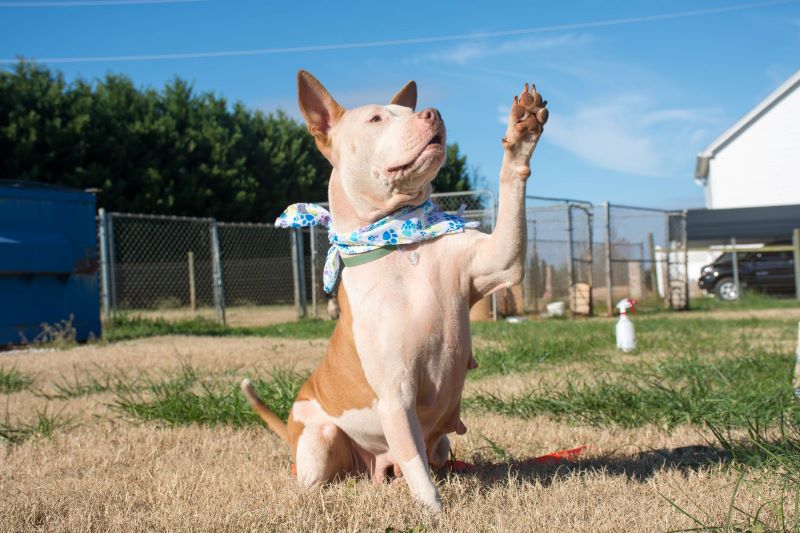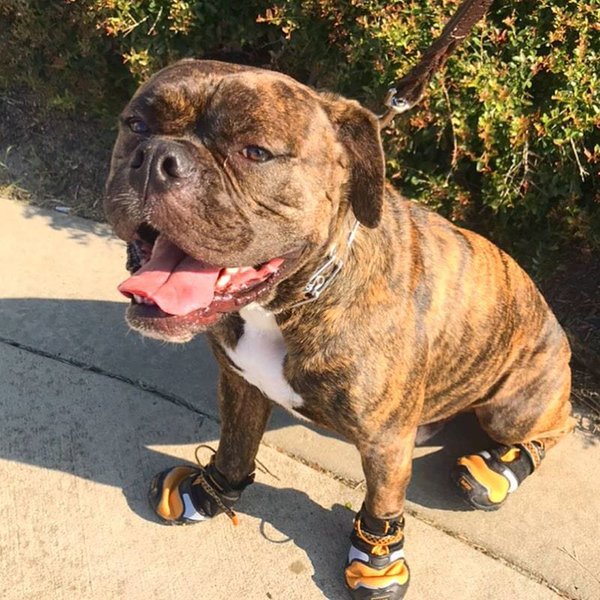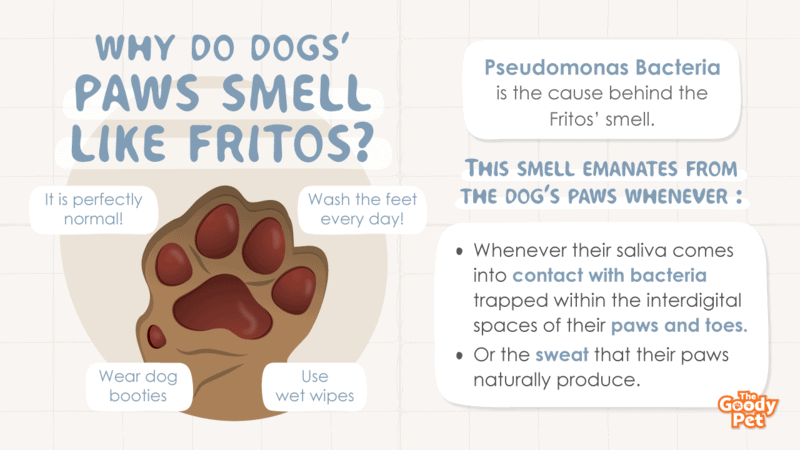Do you ever wonder why you smell your favorite corn chips when your pet pooch is around without having opened a bag of chips? Can it be that your dog has stepped onto some Fritos or popcorn lying around? Checking your pet for the origin of that smell, you may be surprised to know that it is emanating from its feet.
The yeasty smell of corn chips emanates from the dogs’ paws whenever their saliva comes into contact with bacteria trapped within the interdigital spaces of their paws and toes. Adding to that is the sweat that their paws naturally produce. Many refer to this as “Frito feet.”
Our dogs walk throughout the day, either around the house or outside, and their paws pick up all sorts of bacteria. Two of the common bacteria that attach to their feet are the Pseudomonas and the Proteus bacteria.
In this article, we will discuss the various ways you can deal with these bacteria, minimize the smell, and understand the treatment methods in case the smell gets out of hand and becomes unbearable.
Is It Normal For Dogs’ Feet To Smell Like Corn Chips?
Yes, it is perfectly normal for your dog’s feet to have an odor and sometimes like that of corn chips.
Even if we clean their paws and feet thoroughly, there is always the possibility that they won’t smell clean. It’s because their feet are always exposed to the ground, especially when they dig around dirt a lot. Here is more information about your dog’s paws.

Are Dogs’ Paws Supposed To Smell?
Yes, a little bit of odor on dogs’ feet is nothing to worry about. When they go about their various activities, it is normal for bacteria to adhere to their paws.
When their paws are not dried out completely, the bacteria will naturally grow rapidly, causing the smell. This is especially true if your dog’s fur around its feet is not trimmed regularly.
One bacteria that gives that Fritos’ smell is the Pseudomonas bacteria which is practically found anywhere, especially in soil and water. This bacteria is also present inside your house, like on the kitchen floor and the bathroom.
The Proteus bacteria is also widely present in nature, mainly in the decomposing animal matter, sewage, and manure soil. It is also naturally present on our skin as well as in a lot of mammals.
These bacteria are all harmless and pose no threat to us and our pooch’s health as long as there is a healthy balance between good and bad bacteria.
Do Dogs Sweat Through Paws?
Yes, dogs sweat through their paws and other parts where fur is not growing.
Their paws, in particular, have a type of gland called merocrine glands that activate to produce sweat when their body wants to cool down. This is the reason why you see damp paw prints on the ground when the temperature is warm.
Since dogs are covered in fur, it is much more efficient for their bodies to sweat through their paws. Cooling only takes place when sweat evaporates, and if sweat glands are located where fur is present, then there will be no evaporation.
Why Does My Dog Smell More When He Sleeps?
Your dog seemed to be more smelly at night because our sense of smell is stronger during the early evening. You may also notice the smell more because there are fewer competing odors during the night when there is much less activity.
How Do I Stop My Dogs’ Feet From Smelling Like Corn Chips?

Regularly cleaning your dog’s feet is the best way to stop your dog’s paws from smelling like Fritos. Washing them regularly after walking outdoors will do the trick. Just make sure to get them dry to avoid moisture accumulation.
It should also be noted that the corn chip smell can also emanate from other parts of the skin. Bacteria accumulation can occur on the ears, body, and face, especially if your dog has lots of wrinkles where the microorganisms can hide.
What are the signs that your dog needs veterinary care? How do you treat and disinfect your dog’s paws if they are infected with fungal infection? Read on for more tips on how to stop your dog’s feet from smelling like Fritos.
Set An Appointment With A Veterinarian
To stop the corn chip smell, here are the signs to look out for that warrant a visit to a vet clinic. First, if you notice that the odor has become stronger than usual, then this is a sign that there is an infection in the paw area.
Second, look for indications of fungal infection, such as redness, excessive itching, swelling, abnormal discharge, and limping.
Excessive licking may even exacerbate the problem. It’s because the paws can get injured. If this happens, those dogs with some health problems can get their immunity compromised if the bacteria enter their bloodstream.
Third, if you notice inflammation in the paw area, then this can be a sign that your dog has pododermatitis. When there is an overgrowth of bacteria and yeast, it may inflame the interdigital spaces, footpads, nails, and nail folds. This condition can be painful for your pet and impair his walking.
Other causes of infection can be allergies, injuries, ticks, or yeast infection.
Medical Treatment For Yeast Infection
Yeast infections are diagnosed by examining the skin cells through a microscope. Treatment includes the application of topical antifungal creams, sprays, and shampoos. These products contain active ingredients such as ketoconazole, chlorhexidine, or miconazole.
In severe cases, the veterinarian may prescribe oral antifungal medications with fluconazole, terbinafine, itraconazole, and ketoconazole.
Disinfect Your Dog’s Paws
If you are having difficulty cleaning its paws because your dog doesn’t want it to be touched, you can opt to soak the paws instead.
You start by filling a tray with 1 gallon of water, 1 cup of hydrogen peroxide, and 1 cup of apple cider vinegar. Soak the feet for about 5 minutes and dry them afterward.
The vinegar helps with increasing the pH of the skin to make it less conducive for bacteria to accumulate.
How To Prevent My Dog’s Feet From Smelling Like Corn Chips?
If the bacteria on your dog’s paw start to accumulate too much, there are several things you can do to minimize the foul smell. We recommend wiping the paws with wet wipes, washing your dog’s paws and feet every day, trimming the hair around the paws, and letting your dog wear booties.
Use Wet Wipes
The first and simplest way is to wipe it with a damp rag soaked in soapy water. It is important to wipe the pads thoroughly, especially between the toes, the nails, and the nail beds. Afterward, wipe it again with a soapless rag to take out any soap residue and dry it completely.
For convenience, one product we can recommend is Glandex Dog Wipes for Pets Cleansing & Deodorizing Anal Gland Hygienic Wipes.
It is safe for daily use in sensitive areas but strong enough to clean and deodorize funky odors and mess. It also contains Aloe and vitamin E for a healthier coat and skin.
Washing Of The Feet
Washing the feet every day after a long walk or just a romp around the house will rid the feet of any mud, dirt, or debris.
This is much better than giving your dog frequent baths. Bathing the entire body frequently strips the coat of natural oils that keep the skin healthy. It can also lead to dry and itchy skin.
Plus, washing the feet frequently also has the added benefit of letting you check on your dog’s paws for any cuts, injuries, inflammation, and ticks. A lot of ticks like to hide between the toes and are not readily seen if not checked regularly.
We highly recommend that you use dog shampoo or soap that has milder ingredients compared to what we use for ourselves. Harsh chemicals can cause problems if our dog takes in too much of it when they lick their paws.
Trim The Hair
Consider trimming the hair around the paws. Clearing the fur around their paws allows for easy cleaning and prevents the area from getting excessively matted, leading to yeast infections.
Trimming their nails regularly also prevents torn or broken nails that will otherwise injure their paws.
Dog Booties

Another option is to protect their paws with a pair of dog booties. Booties keep their feet free from dirt and grime and protect them from extreme heat and cold when walking outside.
Also, during the winter, the presence of road chemicals, salt, and sharp ice can wreak havoc on their paws. There are many instances when dogs suffer from chemical burns, irritation, and bacterial infections.





